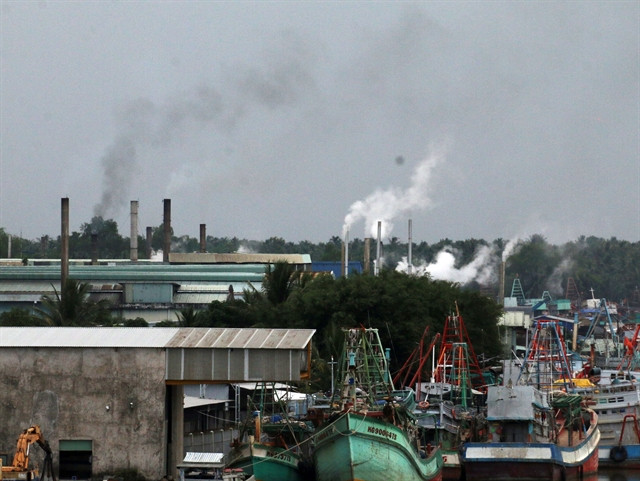 |
| Emissions from a fisheries factory by Cái Bé River, Kiên Giang province in 2021. VNA/VNS Photo Lê Sen |
In response to the evolving economic and social landscape in the country, Vietnam's Ministry of Finance has announced measures to address the deteriorating air quality in major cities, industrial zones and craft villages. The worsening environmental conditions pose serious threats to public health, inflict damage on the economy, and jeopardize the overall well-being of the environment.
The Ministry of Finance recently proposed a method and formula to calculate the Environment Protection Fee for emissions in a draft decree to the Government.
According to the draft, there are two methods for emissions fee calculation.
Method one is for organisations that need regular emission monitoring. These organisations must pay a quarterly fee of VNĐ750,000 (US$31), plus a variable cost in accordance with this table:
| Pollutant | Cost in VNĐ per tonnes (US$/tonnes) |
| Fine dust particles | VNĐ800 (US$0.033) |
| Nitrous oxides (includes NO2 & NO) | VNĐ800 (US$0.033) |
| Sulphur oxides | VNĐ700 (US$0.029) |
| Carbon oxide | VNĐ500 (US$0.021) |
Method two is for organisations that do not require constant emission monitoring. These organisations only have to pay a fixed annual fee of VNĐ3 million (US$123.7)
The draft also proposed bonuses for organisations that restrict pollutant emissions.
Organisations that have a pollutant concentration level lower or equal to 30 per cent of the amount regulated in the National Technical Standards of Industrial Emission only have to pay 75 per cent of the fee, in accordance with the aforementioned formula.
Organisations that have a pollutant concentration level from 30 per cent to less than 50 per cent of the amount regulated in the National Technical Standards of Industrial Emission only have to pay 50 per cent of the fee, in accordance with the aforementioned formula.
Fee collecting organisations must transfer all collected fees to the state budget.
Currently, the nation boasts approximately 5.1 million cars and a large number of motorcycles in circulation. There are also numerous industrial complexes, including those focused on bauxite production, steel manufacturing, oil refining and power plants, which discharge substantial industrial emissions daily. Additionally, there are around 120,000 industrial production facilities, with 138 identified as causing serious environmental pollution.
According to the draft regulations, two sources of pollution — dust and industrial emissions — require management and control. These sources include: vehicles, machinery, equipment, and construction projects emitting dust and industrial emissions, as well as production, business and service facilities emitting industrial emissions.
Some suggestions propose imposing environment protection fees on all types of emissions causing environmental pollution and all emission sources mentioned above. However, determining environment protection fees for emissions must ensure feasibility, effectiveness, and alignment with the current economic and social conditions.
The establishment of an environment protection fee for emissions is deemed necessary to institutionalise the Party and the State's policies, construct a comprehensive legal system on fees suitable to practical environmental protection conditions, and gradually raise awareness about environment-impacting activities among pollutant-emitting organisations and individuals, and society as a whole.
Timely and reasonable mobilisation of resources from emission sources will create funding for environmental protection activities related to air quality. VNS